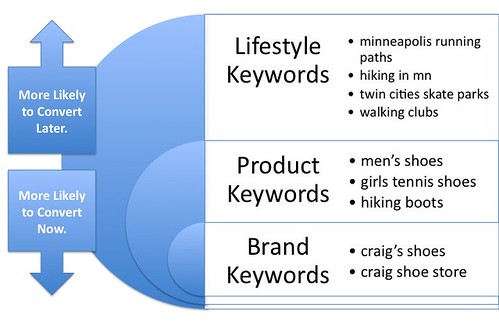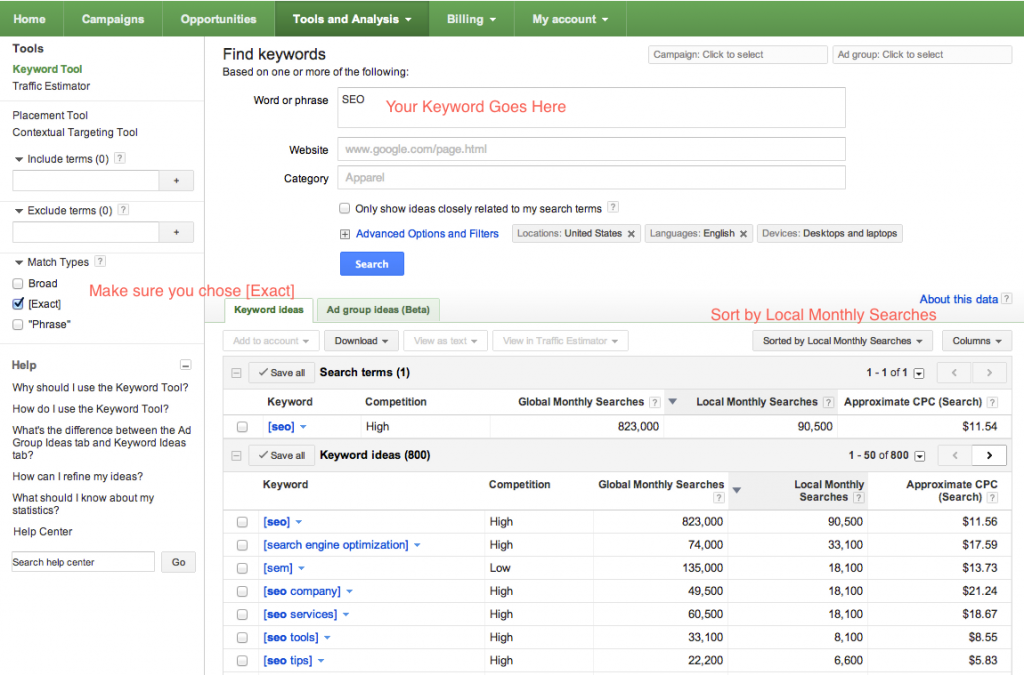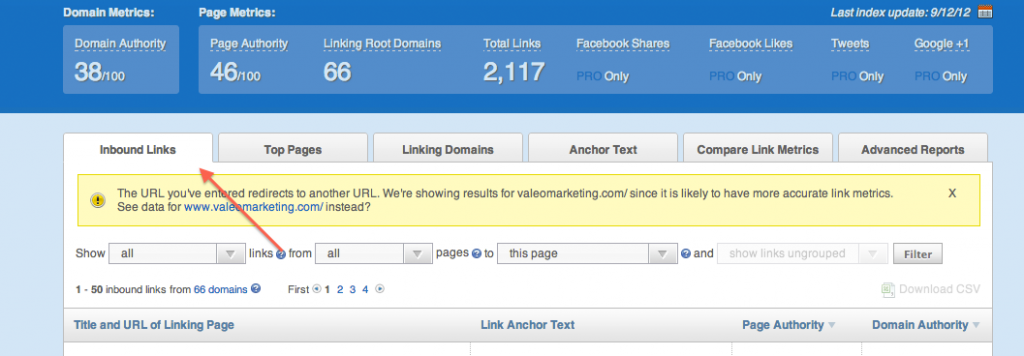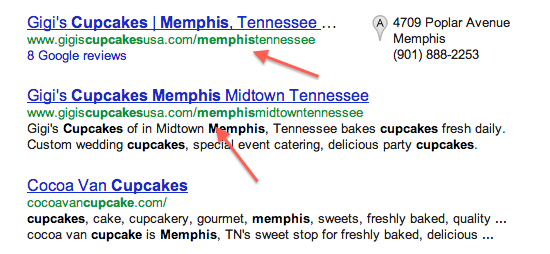SEO Research: Understanding Your Online Presence
Your search engine optimization campaign will always start with research and planning. In this phase, you’ll need to determine your goals for your SEO campaign and develop a strategy for effectively meeting them.
Identifying the Right Keywords for SEO Research
There’s a common misconception that research only involves picking out some high volume keywords (the words or phrases being entered into search engines) that relate to your website. The truth is that it’s not just about picking out keywords with the most monthly searches, but it’s about picking out the keywords that will drive high-conversion traffic your site.
So, how do you determine which keywords are the right keywords? If you’re intention is to sell or promote a product or service, you need to focus on keywords that drive conversions, not just the ones with the most traffic. 
For instance, if your business sells cupcakes, you shouldn’t just focus on the broadest search phrases like”cupcakes.” People searching for just “cupcakes” may be looking for a photo of a cupcake or maybe even the history of the cupcake. Instead, think of phrases that specifically describe your product and differentiate it in the market. Maybe that’s something like “cupcakes for Memphis birthday parties” or “cupcakes for New York City delivery”
What word describe your business?
Now, make a list of 5-10 terms that you think accurately describe your business. Once you have that list, it’s time to do some research.
The best tool to get you started with this is the Google Adwords Keyword Tool. It wil let you see terms related to the keywords you thought up on your own, and how many people are searching those terms in Google each month. You will need to sign up for a Google Adwords account and then you’re ready to start researching.
Once you’ve gotten started, you need to configure a few things. First: make sure to check [Exact] in the left column. Next, sort by Local Monthly Searches. Now you’re ready to search your first term.

What you’re looking for here will be the keywords you’ll use when we talk about on-page optimization and in the next step on competitor analysis. Choosing keywords is highly subjective and it can be a challenge to give any hard and fast recommendations. There are a few good guidelines though:
- The more searches a keyword gets, the harder it will be to rank. I’d recommend beginning with keywords that have no more than 1000 local monthly searches, though if you’re in a highly competitive industry, much fewer (a few hundred) is more realistic
- Try to pick keywords that you think will be high-conversion for your business. That means choosing keywords that are very descriptive of what you do or what you sell.
For now, choose 1 keyword for your homepage and each of your major secondary pages. These secondary pages could be specific products and services you offer or categories on your site.
Sticking with our cupcake example, your home page keyword might be “Memphis Birthday Cupcakes” and your the keywords for your main secondary pages might be “Cupcakes for Delivery in Memphis” and “Best Cupcakes in Memphis.”
Competitor Analysis
The next key step in your SEO research should be a thorough analysis of your competitors. This is going to give you an idea of what they’ve done online and how you can use that to map out your own strategy to overcome them. Again, this will vary depending on which keywords you want to go after. Regardless, a thorough knowledge of what you’re up against will greatly improve your success rate.
If you’re main competitor already has a successful SEO strategy in-place, don’t be discouraged. In fact, if you’re competitors are already ranking high in search then you’ll have a great deal of insight into what works and what doesn’t. Save yourself a ton of time and break down what tactics they’re using apply to your own strategy. This can include which keywords to blog about, link strategy, social media strategy or any other tactic that’s boosting their traffic. The bottom line: find what works from those who’ve already have a plan in place and do it better.
Find Your Competitors
- Search the keywords you chose at the end of the previous step. I would recommend using
 Google Chrome’sIncognito mode, so you’re results aren’t biased towards your search history.
Google Chrome’sIncognito mode, so you’re results aren’t biased towards your search history. - Note which domains show up in the top 3 results for your most important queries. If the same domain is showing up for everyone of your keywords, you can bet that that’s one of your competitors
- Make a list of your top 3 competitors in the search engines. Choose the ones that consistently show up near the top for your most important terms for your business, but ignore major brands like Amazon or Zappos.

Looks like “Gigi’s Cupcakes might be one of our competitors. I’ll add them to the list.
Analyze your Competitors – The Numbers
The next step is to analyzer your competitors’ back links. In search engines’ eyes, links to your site are seen as votes. Though there are a lot of additional factors, there is a strong correlation between the number of links going to a site and how well it ranks in the search engines. In the eyes of the search engines, links are seen as “votes.” Since every search engine wants to return the best possible results, they use the number of “votes,” or links as an important factor to judge the authority and value of a site. In general, that means more links=better rankings
Head on over to Open Site Explorer (paid, but a free 30 day trial, and 3 free searches per day without signing up) for the next step. Put in the URL of your company website and whoever you identified as yout top 3 competitors. There is a ton of data in here, but we want to focus on the main bar at the top and pick out 3 metrics
- Domain Authority – Overall strength of a domain as judged by SEOmoz
- Link Root Domains – number of different domains with links pointing at the target site
- Total Links – total number of links pointing at the target site


This comparison should give you a basic idea of where you stand SEO-wise in comparison to your main competitors. In general, if two websites are in the same niche, the one with the higher domain authority, number of linking root domains, and total links will rank higher. These are some of the major factors in Google’s algorithm, but they are in the end only a handful of more than a reported 200 different factors, so it’s entirely possible that your site might have more total link and a higher domain authority, but still rank worse than a competitor’s site. Nonetheless, this will give you a good idea of how much work you need to do moving forward to maximize your online visibility.
Analyze Your Competitors – The Strategy
Now you’ve got the raw numbers, but you still don’t know how they got all those links. Staying inside Open Site Explorer, look first at the “inbound links” tab.

This will show you the most valuable links that site has pointing to it. Make note of any that you think you could emulate or seem like something you might be able to incorporate into your SEO campaign. Going back to our comparison of links to votes, are there any sites here that you think you could develop a relationship with and have them “vote’ for you? Are there any organizations linking to them that you already are a member of or could join? Are they participating on relevant industry forums or blogs?
Once you’ve looked through some of their most valuable links, click on the “top pages” tab.

This will show you which pages on their site have been linked to the most. The index page or home page is usually the most popular, but look a little further down the list. Have they released any interesting tools, articles, or guides? Make note of what people seem to be linking to on your competitors’ sites and think how you could create even better content.
If your ferocious cupcake shop across the street has some popular recipes on their site, why don’t you do some videos showing people how you make some of your most famous cupcakes? Or maybe a guide on how to throw the best birthday party ever (a cupcake themed one, of course ;)).
Once you’ve gone through this, you should have a good idea of what keywords you need to be targeting (we’ll cover the first steps on how to do that in the next email), where you stand in relation to your main competitors, what they’ve done to get ahead of you, and how you can copy it.
Action Steps:
At the end of every post in our SEO Series, we’ll go over a few action steps for you to take between now and you’re next email. Here’s your first assignment ;).
- Make a Keyword list of 5-10 keywords that describe your business
- Create a Spreadsheet using the steps outlined above
- Note where your competitors’ links are coming from and to what pages they’re going





